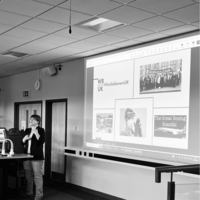Olga Lainidi
University of Leeds, Psychology, Graduate Student
- PhD student
Psychologistedit
Burnout is a significant challenge in the workplace. Its extent is global and its unfavourable consequences are diverse, affecting the individual, the organization, and society. The aim of the present study was to examine the adaptation... more
Burnout is a significant challenge in the workplace. Its extent is global and its unfavourable consequences are diverse, affecting the individual, the organization, and society. The aim of the present study was to examine the adaptation and assess the validity of the Greek version of the Burnout Assessment Tool (BAT). The adaptation process included the translation and back-translation of the BAT. Data were collected from 356 Greek employees from diverse sectors. Confirmatory factor analysis and item response theory were utilized to assess the validity of the Greek version of the BAT. According to the findings of the present research, the core symptoms scale and the secondary symptoms scale of BAT-23 and BAT 12 models demonstrated adequate structures for the analysis and measurement of burnout in the Greek context. Finally, the psychometric performance of the BATGR-12 compared to the BAT-GR-23 establishes it as a more optimum instrument for the assessment of burnout across Greek working adults.
Globally, adolescents and young adults are calling for action from governments on global humanitarian crises, taking on leadership roles that have contributed to redefining leadership in terms of behavior and action rather than qualities... more
Globally, adolescents and young adults are calling for action from governments on global humanitarian crises, taking on leadership roles that have contributed to redefining leadership in terms of behavior and action rather than qualities and status. However, there is a significant gap with regard to the conceptual and theoretical understanding of how adolescents and young adults experience leadership. In this paper, we present the results of two qualitative studies that examined the phenomenon of leadership among adolescents and young adults. Study 1 involved interviews with young adult leaders to analyze the fit between traditional leadership theories and their experience of leadership. Following this, Study 2 utilized the results from Study 1 to design a diary study of adolescents attending a leadership program. Both studies revealed that leadership is experienced as a pathway that involves three mechanisms of transferability: sensemaking, action and reflection. The findings of th...
Research Interests:
(1) Background: The aim of the study was to investigate if the Dark Triad (DT)—which includes psychopathy, Machiavellianism and narcissism—impulsiveness and Honesty-Humility (HH), can predict individuals’ intended behavior in a one-shot... more
(1) Background: The aim of the study was to investigate if the Dark Triad (DT)—which includes psychopathy, Machiavellianism and narcissism—impulsiveness and Honesty-Humility (HH), can predict individuals’ intended behavior in a one-shot Prisoner’s Dilemma Game (PDG) and whether this relationship is moderated by gender. (2) Methods: A cross-sectional correlational design was used, examining regression and moderation models. A total sample of 197 working adults from Greece (64% women, Mage = 35.13 years old) completed a one-shot, simulated PDG, the Dirty Dozen scale, the Barratt Impulsiveness Scale and the Honesty-Humility subscale from the HEXACO NEO-PI. (3) Results: Significant correlations between overall DT score, narcissism and psychopathy scores and impulsiveness and all three DT traits, as well as the overall DT score and honesty-humility, were identified. Overall DT scores were found to increase the odds of defecting, while gender significantly moderated the effects of Machiavellianism, HH and impulsiveness on the participants’ behavior in the one shot PDG, leading to different effects for men and women. (4) Conclusions: Gender moderates the relationship between certain personality traits and behavior in social situations involving interdependence and/or moral decision making, such as the PDG, leading to changes both in terms of the statistical significance and the direction of the effect. Simulated social situations could serve as situational judgment tests in an effort to develop a better understanding of the underpinning mechanisms between personality, gender and social behavior.
Research Interests:
A significant amount of emotional labor takes place during teaching. Teaching is a multitasking profession that consists of both cognitive and emotional components, with teachers engaging in emotional labor on a daily basis as an... more
A significant amount of emotional labor takes place during teaching. Teaching is a multitasking profession that consists of both cognitive and emotional components, with teachers engaging in emotional labor on a daily basis as an instrumental part of achieving teaching goals and positive learning outcomes. The purpose of the present review was to explore the relationship between emotional labor and burnout in school settings. The review focused specifically on teachers from elementary and high schools, between January 2006 and August 2021, and 21 studies fit the inclusion criteria. Overall, the review of the literature supports the significant associations between burnout and emotional labor with the majority of results pointing to the consistent relationship between surface acting and burnout. However, the results regarding the association of deep acting and naturally felt emotions with burnout were mixed. There is considerable scope for improvement in our study of emotional labor ...
